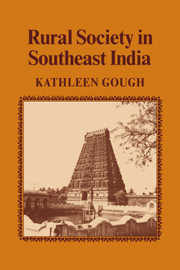Book contents
- Frontmatter
- Contents
- Preface
- Part I Thanjāvūr
- 1 The District
- 2 Castes and Religious Groups
- 3 The Agriculturalists
- 4 The Nonagriculturalists
- 5 Variations in Ecology, Demography, and Social Structure
- 6 The Colonial Background and the Sources of Poverty
- 7 Political Parties
- Part II Kumbapeṭṭai
- Part III Kirippūr
- Notes
- Glossary
- Bibliography
- Index
- CAMBRIDGE STUDIES IN SOCIAL ANTHROPOLOGY
1 - The District
from Part I - Thanjāvūr
Published online by Cambridge University Press: 29 October 2009
- Frontmatter
- Contents
- Preface
- Part I Thanjāvūr
- 1 The District
- 2 Castes and Religious Groups
- 3 The Agriculturalists
- 4 The Nonagriculturalists
- 5 Variations in Ecology, Demography, and Social Structure
- 6 The Colonial Background and the Sources of Poverty
- 7 Political Parties
- Part II Kumbapeṭṭai
- Part III Kirippūr
- Notes
- Glossary
- Bibliography
- Index
- CAMBRIDGE STUDIES IN SOCIAL ANTHROPOLOGY
Summary
Towns and Temples
Thanjāvūr district lies in the extreme southeast of India, jutting out into the Bay of Bengal. In 1951, three years after the independence of India, it was one of twenty-six districts of the state of Madras (see Map 1). The neighboring districts were South Ārcot to the north, Tiruchirappalli to the northwest and west, and Rāmanāthapuram in the extreme southwest. To the southwest, the small state of Pudukoṭṭai, formerly governed by a Rāja, had recently been incorporated into Tiruchirappalli district. In 1956 the eleven Tamiḷ-speaking southern districts of Madras were combined with Kanya Kumāri in the extreme southwest to form a new state, which in 1962 was given its ancient name of “Tamiḷ Country” or Tamiḷ Naḍu.
Thanjāvūr's nearest large city was Madras, the state capital, as the crow flies 160 miles north-northwest of Thanjāvūr municipality, the district's capital town. Tiruchirappalli (population 218,921 in 1951), sixty-six miles west of Thanjāvūr, and Madurai (population 361,781 in 1951), one hundred miles southwest, were the two other large centers visited by the elite and the more adventurous working people. Tiruvannāmalai in North Ārcot, Tirupati in Chittur, Chidambaram in South Ārcot, Kānchipuram in Chingleput, Rāmēswaram in Rāmanāthapuram, and Tiruchendūr in Tirunelēli were religious centers to which the devout of Thanjāvūr, especially Brahmans, made pilgrimages.
Thanjāvūr municipality, once a magnificent capital several times its modern size, had a population of 100,680 in 1951 (see Map 2). It was a sacred center at least 1,000 years old, renowned for its Brahadeeswara Temple, which was constructed by the Chōḷa King Rājarāja I in the tenth and eleventh centuries.
- Type
- Chapter
- Information
- Rural Society in Southeast India , pp. 1 - 16Publisher: Cambridge University PressPrint publication year: 1982

